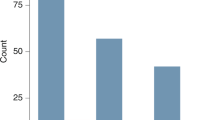Abstract
On first impression, the disciplines of genetics and political science would appear to be unrelated. And yet, commencing more than 30 years ago, the interdisciplinary field known as Biopolitics has now taken hold. This essay traces the central thrust of the biopolitical research agenda. It describes, analyzes, and assesses how political scientists have sought to show connections between our species' genetic constitution and our species' political behavior. Important bridges between the two are the neurophysiology of the human brain and the role of evolutionary theory in charting man's adaptational political profile. The parameters of the emerging biopolitical literature raise profound policy questions, some of which are also characterized.
Similar content being viewed by others
References
Andrews, L.B. & D. Nelkin, 1996. The Bell Curve: A statement. Science 271: 13.
Axelrod, R., 1986. An evolutionary approach to norms. American Political Science Review 80: 1095–1111.
Axelrod, R., 1987. The evolution of strategies in the iterated Prisoner's Dilemma, in Genetic Algorithms and Simulated Annealing, edited by Lawrence Davis. Pitman, London.
Axelrod, R. & W.D. Hamilton, 1981. The evolution of cooperation. Science 211: 1390–1396.
Browne, M.W., 1993. Mozart makes the brain hum. The New York Times, Oct. 8, B1.
Brunner, H.G., M. Nelson, X.O. Breakefield, H.H. Ropers & B.A. van Oost, 1993. Abnormal behavior associated with a point mutation in the structural gene for monoamine oxidase A. Science 262: 578–580.
Carmen, I.H., 1987. Bioconstitutional politics: Toward an interdisciplinary paradigm. Politics and the Life Sciences 5: 193–207.
Carmen, I.H., 1989. Chess algorithms of Supreme Court decision making: A bioconstitutional politics analysis. Political Behavior 11: 99–121.
Chomsky, N., 1980. Rules and Representations. Columbia University Press, New York.
Cipra, B., 1996. Will a computer checkmate a chess champion at last? Science 271: 599.
Corning, P.A., 1983. The Synergism Hypothesis. McGraw Hill, New York.
Cosmides, L. & J. Tooby, 1987. From evolution to behavior: Evolutionary psychology as the missing link, in The Latest on the Best, edited by John Dupré. MIT Press, Cambridge.
Culliton, B.J., 1975. XYY: Harvard researcher under fire stops newborn screening. Science 188: 1284–1285.
de Groot, A.D., 1965. Thought and Choice in Chess. Mouton, The Hague.
Deutsch, K.W., 1951. Mechanism, organism, and society: Some models in natural and social science. Philosophy of Science 18: 230–252.
Hamilton, W.D., 1964. The genetical evolution of social behavior, I and II. Journal of Theoretical Biology 7: 1–52.
Herrnstein, R.J. & C. Murray, 1994. The Bell Curve. Free Press, New York.
Holden, C., 1996. Happiness and DNA. Science 272: 1591–1593.
Kevles, D.J., 1985. In the Name of Eugenics. Knopf, New York.
Lasswell, H.D., 1950. Politics: Who Gets What, When, How? P. Smith, New York.
Lewontin, R.C., S. Rose & L.J. Kamin, 1984. Not in Our Genes. Pantheon Books, New York.
Lumsden, C.J. & E.O. Wilson, 1981. Genes, Mind, and Culture. Harvard University Press, Cambridge.
Lumsden, C.J. & E.O. Wilson, 1983. Promethean Fire. Harvard University Press, Cambridge.
MacLean, P.D., 1982. A triangular brief on the evolution of brain and law. Journal of Social and Biological Structures 5: 369–379.
Madsen, D., 1985. A biochemical property relating to power seeking in humans. American Political Science Review 79: 448–457.
Mann, C.C., 1994. Behavioral genetics in transition. Science 264: 1686–1689.
Masters, R.D., 1983. The biological nature of the state. World Politics 35: 161–193.
Masters, R.D., 1989. The Nature of Politics. Yale University Press, New Haven.
Masters, R.D. & D.G. Sullivan, 1989. Nonverbal displays and political leadership in France and the United States. Political Behavior 11: 123–156.
McGuire, M., M. Raleigh & C. Johnson, 1983. Social dominance in adult male vervet monkeys II: Behavior-biochemical relationships. Social Science Information 22: 311–328.
McGuire, T.R. & J. Hirsch, 1977. General intelligence (g) and heritability (H2, h2). In The Structuring of Experience, edited by Ina C. Uzgiris & Fredric Weizmann. Plenum, New York.
Michod, R.E., 1994. A science of fitness (review of Ecological Genetics, edited by Leslie A. Real). Science 266: 468–470.
Morton, O., 1995. A survey of biotechnology and genetics. The Economist, Feb. 25, 3–18.
Nowak, R., 1995. Brain center linked to perfect pitch. Science 267: 616.
Pool, R., 1995. Putting game theory to the test. Science 267: 1591–1593.
Raleigh, M., A. Yuwiler, G. Brammer, M. McGuire, E. Geller & J. Flannery, 1981. Peripheral correlates of serotonergically influenced behaviors in vervet monkeys. Psychopharmacology 72: 241–246.
Roberts, M., 1938. Bio-Politics: An Essay in the Physiology, Pathology, and Politics of the Social and Somatic Organism. Dent, London.
Schubert, G., 1982. Epigenesis: The newer synthesis. Behavioral and Brain Sciences 5: 24–25.
Simon, H.A., 1979. Models of Thought. Yale University Press, New Haven.
Somit, A., 1968. Toward a more biologically-oriented political science: Ethology and psychopharmacology. Midwest Journal of Political Science 12: 550–567.
Somit, A. & S.A. Peterson, 1990. Biopolitics and Mainstream Political Science: A Master Bibliography. Northern Illinois University, DeKalb, IL.
Steiner, G., 1972. Fields of force. The New Yorker, Oct. 28, pp. 42–117.
Thorson, T.L., 1970. Biopolitics. Holt, New York.
Trivers, R.L., 1971. The evolution of reciprocal altruism. Quarterly Review of Biology 46: 35–57.
van Hoof, J.A.R.A.M., 1969. The facial displays of the catarrhyne monkeys and apes, in Primate Ethology, edited by Desmond Morris. Anchor Books, New York.
van Hoof, J.A.R.A.M., 1973. A structural analysis of the social behavior of a semi-captive group of chimpanzees, in Social Communication and Movement, edited by Mario von Cranach & Ian Vine. Academic Press, New York.
Wiesel, T., 1994. Genetics and behavior. Science 264: 1647.
Wilson, E.O., 1975. Sociobiology: The New Synthesis. Harvard University Press, Cambridge.
Wilson, J.Q., 1993a. The Moral Sense. Free Press, New York.
Wilson, J.Q., 1993b. The moral sense. American Political Science Review 87: 1–11.
Wilson, J.Q. & R.J. Herrnstein, 1985. Crime and Human Nature. Simon and Schuster, New York.
Author information
Authors and Affiliations
Rights and permissions
About this article
Cite this article
Carmen, I.H. Biopolitics: the newest synthesis?. Genetica 99, 173–184 (1997). https://doi.org/10.1007/BF02259521
Received:
Accepted:
Issue Date:
DOI: https://doi.org/10.1007/BF02259521




